Abstract
The coffee industry generates a significant amount of wastewater that is rich in organic loads and is highly acidic. The present study investigates the potential of the heterogeneous photocatalytic oxidation process to reduce the pollutant load in coffee processing wastewater. The experimental runs were conducted to evaluate the effect of operative parameters such as pH, catalyst dosage, intensity of UV light irradiation, and addition of oxidant on Chemical Oxygen Demand (COD) and colour reduction. Significant results for COD and colour removal, 67%, and 70% respectively, were achieved at a pH of 4 with titanium dioxide (TiO2), and a catalyst dosage of 500 mg/L, using four ultraviolet-C (UV-C) lamps of 16 W each. With the addition of hydrogen peroxide (H2O2) as an oxidant, the removal efficiency increased to 84% and 75% for COD and colour, respectively. Finally, the best results obtained by photocatalytic degradation using UV light were compared to those using solar light. Based on the investigation, it was inferred that the pollutant removal efficiency in coffee pulping wastewater was also considerably high under sunlight. These findings may have relevance in terms of application in countries where coffee processing is carried out and where sunlight irradiance is usually strong: the technique could be exploited to decrease the pollutant content of this wastewater sustainably.
1. Introduction
Coffee belongs to the genus Coffea of the Rubiaceae family, and the two well-known species of coffee grown are the Arabica and Robusta []. There has been a steady growth in world coffee production, reaching about 170 million 60 kg bags in the crop year 2019–2020, with India accounting for 3% of it []. Coffee is processed by dry and wet methods in which the wet method yields superior quality coffee compared to the dry one. In the conventional wet processing method, the coffee industry uses a massive quantity of water during the various stages of the process. Wet processing of coffee involves the removal of outer parts of the fruit, including the skin, pulp, mucilage layer, and the parchment. Thus, this is an essential step in coffee production that decides the quantity of wastewater generated and of coffee pulp. In small-scale companies using mechanical pulpers, water usage for coffee processing varies from 2.25 to 23 m3 per ton of processed fruit, suggesting the potential of wastewater generation [,].
The wastewater from wet coffee processing can be divided into two parts: (i) wastewater generated during the removal of mesocarp, that is, the pulp of the cherry which contains fermenting sugars, and (ii) wastewater generated during fermentation and washing, which contains hydrolysed pectins. The resultant wastewater is acidic and rich in total suspended solids, which are biodegradable. Additionally, it contains proteins, carbohydrates, fibres, fats, caffeine, polyphenols, pectins, nitrates, ammonium, tannic acids, high levels of soluble organic matter, and deficient dissolved oxygen levels. It is characterized by unacceptable odour, colour, high Biological Oxygen Demand (BOD) and high Chemical Oxygen Demand (COD) [,,,,]. The concentrations of pollutants vary with the quantity of water used when processing the fruits. Wastewater released from this operation without treatment has the potential to pollute the land and receiving water body, causing harmful effects on domestic users, aquatic life, livestock and the watercourse down the stream [].
In developing countries, the disposal of wastewater from coffee processing is a severe environmental issue wherein the effluents are discharged unwisely into nearby natural water bodies which flow into rivers and/or infiltrate into groundwater and thus deteriorating the water qualities. There are several approaches, such as anaerobic–aerobic settling ponds, biogas reactors, land application by irrigation, and wetlands that are useful to control this pollution. In general, biological treatment systems could be suitable for this wastewater as it contains elevated BOD and COD []. However, the conventional biological treatment plants, usually adopted for municipal wastewater, should be modified to obtain a high pollution removal efficiency: at least, the neutralization (to increase the acidic pH) and the coagulation–flocculation steps (to remove colloids and recalcitrant suspended solids) should be added.
Though these approaches reduce the pollution level, the total cost makes it expensive for companies. Hence, there is a need to curb this problem through innovative and eco-friendly techniques. The heterogeneous photocatalysis has proved to be efficient for the treatment of wastewater [,,]. It can degrade organic compounds such as alcohols, carboxylic acids, phenols into harmless products such as carbon dioxide and water [,].
Photocatalysis is considered an effective system for the mineralization of many organics through the generation of radicals such as HO• and O2•−, reducing the organic load of effluents considerably using procedures with relatively low costs [,]. The principle involves the initial absorption of photons with energy equal to or greater than the bandgap energy of the semiconductor, leading to the formation of electrons and holes. The semiconductors are mainly titanium dioxide (TiO2), zinc oxide (ZnO), cadmium sulphide (CdS), zinc sulphide (ZnS). Among these, TiO2 in anatase form has been most commonly studied due to its ability to break down organic pollutants and achieve complete mineralization. Moreover, TiO2 has many advantages over the other catalysts as it is easily available, relatively inexpensive, and chemically highly stable [,,].
A chemical transformation due to acceleration by the catalyst with light is called photocatalysis. The reaction mechanisms are widely known and can be resumed by Equations (1)–(5) [,]:
TiO2 + hυ → ecb− + hvb+
hvb+ + H2O → H+ + HO•
hvb+ + R → intermediates → CO2 + H2O
ecb− + O2 → O2•−
HO• + R → intermediates → CO2 + H2O
The hydroxyl radical has been pointed out as the main responsible species for the oxidative degradation of organic pollutants. Figure 1 shows the mechanism of photocatalysis on an irradiated TiO2 particle.
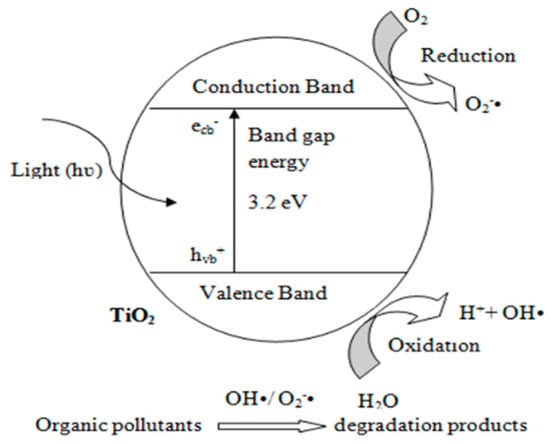
Figure 1.
Photocatalytic mechanism for TiO2 photocatalyst.
Besides, the presence of oxidants, for example, H2O2, can improve the pollution removal, due to the generation of the hydroxyl radical:
ecb− + H2O2 → HO• + OH−
The major factors affecting the TiO2/UV light process are initial organic load, catalyst loading, reactor’s design, temperature, solution pH, UV irradiation time, light intensity, and presence of ionic species. Previous studies on photocatalysis for the degradation of pollutants in industrial wastewater generated by the textile [,,], refinery [], pharmaceutics, and pesticides [,,], cork [] and olive mill [] sectors reveal the effectiveness of the treatment method. However, the detailed literature review indicates that not many studies have been conducted on coffee pulping wastewater treatment using photocatalysis [,]. Satori and Kawase [] studied the colour removal from coffee processing wastewater using ZnO particles. Their findings showed that the dissolved oxygen plays a role in colour abatement, achieving efficient removal only when its concentration was high. When the dissolved oxygen had small concentration or it was absent, the colour removal kinetics increasingly slowed down. The oxygen sparging would seem mandatory to obtain efficient removal, adding an operative cost. Zayas et al. [] found that the combined process of chemical coagulation–flocculation advances oxidation processes, resulting in 87% abatement of COD and colour in the examined wastewater, with process time equal to 120 min. As a whole, the high efficiency is achieved with a complex and expensive sequence of operation, and from the application point of view, this could be an evident drawback.
The present study aimed to evaluate the technical feasibility of photocatalysis for the treatment of coffee pulping wastewater. The study was conducted by irradiating the samples with UV light in a photoreactor and with the sunlight in the presence of a catalyst. The effect of operative parameters such as pH, catalyst dosage, type of catalyst (TiO2 and ZnO were tested), light power on the removal of COD, and colour were highlighted as preliminary results for the future process study on a pilot scale.
2. Materials and Methods
2.1. Characterization of Wastewater
Coffee wastewater was collected from the pulping process from a coffee processing industry located in Karnataka, India. The samples were collected in pre-cleaned bottles, stored at 4 °C in the icebox, and transferred to the laboratory for characterization. The physicochemical parameters such as colour, COD, BOD, pH, turbidity, total suspended solids (TSS), total dissolved solids (TDS), suspended solids (SS), nitrate-nitrogen and phosphate were analyzed as per the standard procedure prescribed by American Public Health Association (APHA) [].
The samples were taken from the same huge tank at the company site; therefore, each experimental run was completed with wastewater having the same chemical and physical properties.
2.2. Catalyst and Reagents
The catalysts used in the photocatalytic degradation process were commercial titanium dioxide (TiO2) and zinc oxide (ZnO). The chemicals used were analytical grade. Different concentrations (0.1 M and 1 M) of HCl and NaOH were used to adjust the initial pH. All the experiments were carried out using double distilled water.
2.3. Experimental Set-Up
The experimental set up consisted of a cubical container (L = 45 cm) with 4 UV-C lamps, with 16 W each and a peak wavelength of 254 nm. The container walls were covered with Al foil for light reflection. Two exhaust fans were fixed on each side of the reactor walls to maintain the temperature inside the reactor. A 1000 mL beaker was placed on a magnetic stirrer inside the container.
2.4. Experimental Methodology
UV photocatalytic degradation of coffee processing wastewater was performed in batch mode for a constant test duration of 3 h. This time was chosen as precautionary, considering that several pollutant compounds contained into coffee wastewater are complex molecules (for example, proteins, phenols, pectins). The working volume of 500 mL was kept in the beaker placed on the magnetic stirrer inside the photoreactor. The various influencing parameters such as pH (2–10), dosage of the catalyst (125–2000 mg/L), UV light irradiation (16 W–64 W), and oxidant dose (600–1200 mg/L of H2O2) were studied by varying the range of each parameter and keeping constant the others. At the end of experimentation, samples of the reaction mixture were withdrawn and filtered using Whatman paper filter (grade no. 42, pore size = 2.5 μm) and analyzed for COD and colour to compare it with the initially measured values of these parameters to evaluate the UV photocatalytic removal efficiency. At the optimized conditions of UV photocatalytic degradation of coffee processing wastewater, the experiments were carried out for the solar photocatalytic process by placing the photoreactor in any light condition to compare its performance to the UV photocatalytic one. The sunlight irradiance was measured by a laboratory lux meter at Vellore Institute of Technology (12.97” N, 79.16” E) when the tests were done, that is, in February. The tests were carried out when the sun had the best irradiance during the day, even if the constant value of irradiance could not be achieved. The coffee effluent COD was measured following the closed reflux titrimetric method using a COD mineralizer according to APHA standards [], while decolourization was measured as a decrease in absorbance at 465 nm by a UV-VIS spectrophotometer. The percentage reduction in COD and colour of the samples were calculated using the Equations (7) and (8), respectively:
where: Ci = initial COD (mg/L), Cf = final COD (mg/L), Cli = initial colour (colour unit), Clf = final colour (colour unit).
The experimental runs had no replicas, while the wastewater analyses were replicated twice. The results, as the average of the doubled replicated analyses, will be shown without error bars and standard deviations, since two replicates cannot support a reliable statistical analysis.
2.5. Kinetic Model for COD Removal
In some experimental runs, the COD concentration was monitored along the run, and this allowed us to model the process kinetics.
The pseudo-first-order model was applied, namely:
where r is the reaction rate, C is the residual COD concentration, t is time, k is the reaction rate constant.
r = dC/dt = −kC
The integration of Equation (9) gives the well-known expression:
where C(t) is the COD concentration (mg/L) at time t, C0 is the initial COD concentration (mg/L), k is the reaction rate constant (min−1), t is time (min).
C(t) = C0 exp (−kt)
The kinetic rate is often used to give the half-life time t1/2, that is, the time by which the initial concentration is reduced to 50%: at t = t1/2, C = C0/2. For the pseudo-first-order model, the half-life time depends only on the reaction rate constant, and it is equal to
t1/2 = ln 2/k = 0.693/k
3. Results
3.1. Characteristics of Wastewater
The physicochemical properties of raw coffee pulping wastewater were analyzed, and the results are presented in Table 1. It can be noted that the wastewater is acidic with a high concentration of COD and colour, which imposes a challenge for the selection of treatment technology. As per the Central Pollution Control Board (CPCB) of Indian Statute, the maximum permitted value of BOD concentration discharge into natural water bodies is 1000 mg/L, and for land application, it is 100 mg/L.

Table 1.
Characteristics of the raw coffee pulping wastewater.
3.2. Effect of Initial pH
The effect of initial pH was one of the most significant factors which influence the photocatalytic degradation of wastewater, as it affects the charge on the catalyst particles, size of aggregates and the position of conductance and valence bands, thus affecting the adsorption of pollutants that happens at the surface of photocatalysts [,].
Figure 2 shows the effect of pH in the range of 2–10. It can be noted from the diagram that the maximum COD reduction and colour removal was achieved at the acidic pH of 4, which is about the pH of the raw coffee wastewater. At a pH of 8 and after 3 h of photocatalytic treatment, the COD and colour removal efficiency was 33% and 45%, respectively, while at a pH of 10, the process provided unsuitable degradation for future application, even if higher than zero. The COD removal was increased by up to 67.4% under acidic conditions (pH of 4) and was then decreased to 60% as pH was further reduced to 2. A similar trend was observed for colour removal. This can be attributed to the fact that TiO2 shows an amphoteric character, that is, positive or negative charge can be developed on its surface. The surface of the TiO2 is positively charged under acidic conditions and negatively charged under alkaline conditions. In acidic media, electrons tend to move into the surface of a catalyst for the electrostatic attraction between the positive charged TiO2 and electrons. They react with the oxygen molecules absorbed around the TiO2 surface to form oxidizing species such as O2•− and •OOH []. The maximum oxidizing capacity of TiO2 is thus at a lower pH, notwithstanding the decrease in reaction rate at a low pH due to excess H+ [].
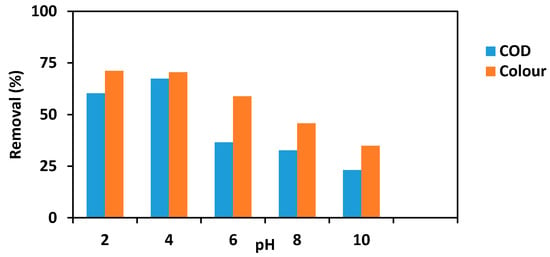
Figure 2.
Effect of pH on photocatalytic degradation (process conditions: TiO2 dosage—500 mg/L, reaction time—3 h, UV light irradiation—64 W).
Moreover, the catalyst has a pH of zero and a point charge of around 6.2, as given by the producer and confirmed by other scientific publications (it was not measured during the experimental runs). Considering the meaning of this parameter and concerning these results, at a pH < 6.2, the particle surface is covered with positive charges and can attract anionic compounds. The results are coherent with this, since the best results were achieved at an acidic pH, and at a pH of 6, the removal efficiency is lower for both the monitored parameters (COD and colour). Regarding coffee processing wastewater, many pollutants tend to be polar or in anionic form; for example, many polyphenols present negatively charged hydroxyphenyl groups that can react with the positively charged particles.
Therefore, the selection of pH needs to be appropriate to achieve maximum degradation efficiency.
3.3. Effect of Catalyst Dosage
At a pH of 4, the TiO2 dosage was varied from 125 mg/L to 2000 mg/L, and the results are presented in Figure 3.
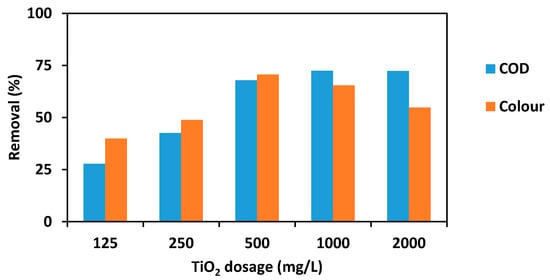
Figure 3.
Effect of catalyst dosage on photocatalytic degradation (process conditions: pH—4, reaction time—3 h, UV light irradiation—64 W).
Regarding COD, it can be observed that as the dosage of the catalyst increases from 125 to 1000 mg/L, the percentage of its removal increases from 28% to 72%, with 72% also at a 2000 mg/L dosage. The increased pollutant removal rate that follows the increase in the catalyst loading can be attributed to the fact that a more significant number of photons are adsorbed, thus accelerating the process.
About the reduction in colour, its trend shows the maximum at a 500 mg/L dosage, achieving 70%; with a further increase in the dosage, the colour removal efficiency decreases to 55% at a 2000 mg/L dosage. This is attributed to the rising of the light scattering due to the presence of TiO2 particles excess []. Hence, the optimum dosage for the maximum degradation of coffee wastewater was considered as 500 mg/L.
3.4. Effect of UV Light Irradiation Power
The influence of light power on the removal efficiency was examined at a pH of 4 and a catalyst dosage of 500 mg/L for 3 h. The effect of UV light irradiation was analyzed by varying the output of UV lamp power from 16 W to 64 W (Figure 4). As expected, from the data, it can be observed that for both the parameters, the removal efficiency increases with an increase in the light irradiation, due to the generation of more electrons and holes []. The UV irradiation generates the photons required for the electron transfer from the valence band to the conduction one of a semiconductor photocatalyst. The energy of a photon is related to its wavelength, and the overall energy input to a photocatalytic process is dependent on light intensity. The degradation efficiency increases when more radiations fall on the catalyst surface, as more hydroxyl radicals are produced [].
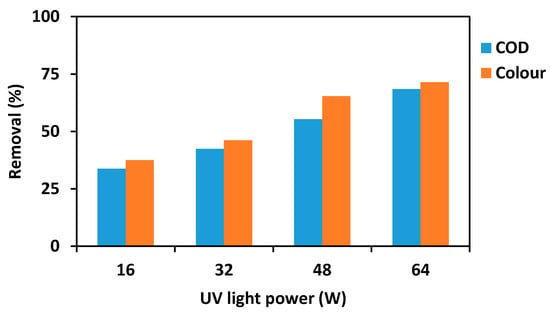
Figure 4.
Effect of UV light irradiation power on photocatalytic degradation (process conditions: pH—4, reaction time—3 h, TiO2 dosage—500 mg/L).
3.5. Effect of Catalyst Type
Although TiO2 is the most commonly used active semiconductor photocatalyst, ZnO is a suitable alternative. ZnO has almost the same bandgap energy (3.2 eV) as TiO2, and its photocatalytic capacity is similar to that of TiO2 []. Table 2 shows the results of degradation by the tested catalysts at optimized conditions. Figure 5 depicts the variation in the rate of degradation induced by TiO2 and ZnO.

Table 2.
Comparison of TiO2 and ZnO on photocatalytic degradation (process conditions: pH—4, UV light irradiation—64 W, catalyst dosage—500 mg/L).
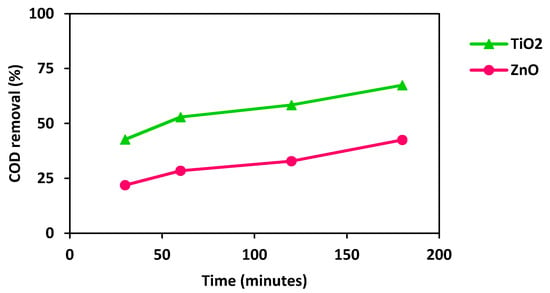
Figure 5.
Effect of type of catalyst on photocatalytic degradation (process conditions: pH—4, reaction time—3 h, UV light irradiation—64 W, catalyst dosage—500 mg/L).
In the present study, zinc oxide showed lesser results compared to TiO2 for the same conditions. Studies carried out by Sakthivel et al. [] have revealed that the quantity of ZnO required to achieve the optimal photocatalytic activity is nearly double that for TiO2 (anatase or rutile), and this supports the results obtained in the present study.
3.6. Effect of Oxidant Addition
The addition of hydrogen peroxide significantly improved the efficiency of photocatalytic degradation of organic compounds. The oxidative photocatalytic degradation was investigated using raw coffee effluent, at a pH of 4, a TiO2 dosage of 500 mg/L, and varying the concentration of H2O2 from 60 mg/L to 1200 mg/L (Figure 6). It can be noted that the removal efficiency first increased when hydrogen peroxide concentration was increased up to 1000 mg/L, reaching 84% of COD removal efficiency. Beyond this, the degradation was reduced to 73% after 3 h of exposure. Radical reaction mechanisms can explain this dual effect of H2O2. The added H2O2 could accelerate the reaction by producing additional hydroxyl radicals (Equation (6)). The generation of additional HO• and other oxidizing species increases the oxidation rate of intermediate compounds. However, by the further addition of H2O2, that is, at a high oxidant concentration, a considerable amount of hydroxyl radicals can be consumed by the oxidant itself [,]:
H2O2 + HO• → H2O + HOO•
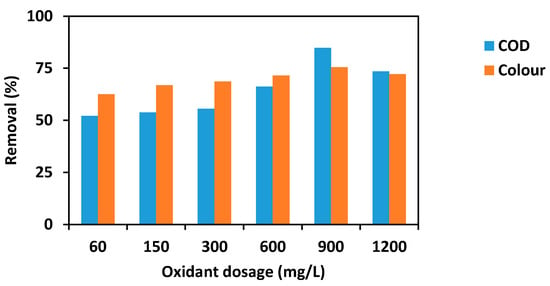
Figure 6.
Effect of oxidant dose on photocatalytic degradation (process conditions: pH—4, reaction time—3 h, UV light irradiation—64 W, catalyst dose—500 mg/L).
The reaction described by Equation (12) is similar to a “parasite” reaction that consumes reactants.
3.7. Comparison of UV and Solar Photocatalytic Degradation
The utilization of sunlight for wastewater treatment is preferred over UV light due to its economics. Hence, in this study, the UV photocatalytic degradation was compared to the solar one (Figure 7). The average solar irradiance was found to be 716 W/m2 during the daily period of experimentation. The pollutant removal efficiency was measured in terms of COD removal at different time intervals. Figure 7 shows that initially, the degradation is low in the solar photocatalytic process when compared to UV photocatalytic degradation efficiency, as the intensity of solar light was low. However, later, the pollutant removal increased up to 65% when the power of solar light reached its daily peak value (912 W/m2). Therefore, it can be inferred that solar photocatalytic degradation can be efficient in the regions receiving high radiation of solar light, reducing the energy cost, and making it sustainable.
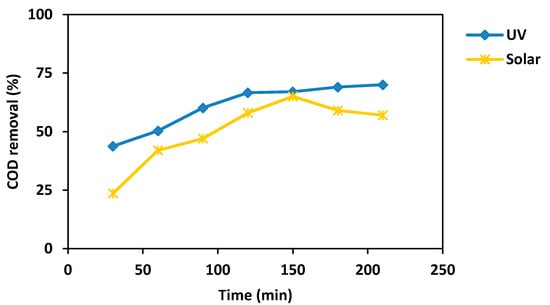
Figure 7.
Influence of incident irradiance on COD removal over the 3.5-h duration test (process conditions: pH—4, UV light irradiation—64 W, catalyst dose—500 mg/L).
3.8. Kinetic Model for COD Removal
As shown in Section 2.5, the kinetics of the COD removal process can be described by the pseudo-first-order model. In this study, a couple of experimental runs were monitored along with the whole test duration, namely:
By Equations (10) and (11), the kinetic rate constant and the half-life time were calculated, and Table 3 reports the results.

Table 3.
Kinetic parameters for COD degradation by TiO2 and ZnO (process conditions: pH—4, UV light irradiation—64 W, catalyst dosage—500 mg/L, C0—28,800 mg/L).
For TiO2, the experimental runs gave similar results, with the half-life time in the range of 87–99 min. In the bottom row, all the data for TiO2 were modelled together.
As expected, ZnO had a much longer half-life time, showing the lower efficiency for COD removal of coffee processing wastewater.
4. Discussion
This study aimed to check the applicability of UV photocatalysis for the treatment of coffee processing wastewater with a TiO2 as catalyst.
The experimental runs were carried out with industrial wastewater produced by an Indian company in Karnataka. In addition to the applicability of the photocatalysis, the effects of the operative parameters were tested, namely, initial wastewater pH, catalyst dosage, UV light power, kind of catalyst and oxidant dosage. Finally, the use of solar light instead of UV was tested, and the performances obtained in both cases were compared.
The application of photocatalysis to treat wastewater is not new. However, many laboratory studies were carried out usually with single pollutants characteristic of specific industrial sectors (textile, refinery, pharmaceutics, and personal care, paper, etc.), and very often focused on colour removal.
The novelty of this study was the use of original industrial wastewater, and the removal of the pollution load (expressed as COD) and colour were the targets.
The experimental runs demonstrated the effectiveness of photocatalysis for the treatment of coffee pulping wastewater. Moreover, the experimental findings allowed us to affirm the following:
- An acidic initial pH gave better removal results than neutral or basic ones for both the targeted parameters (COD and colour). For COD, the highest removal efficiency was achieved at a pH of 4, with the values showing a maximum in the acidic field, while for colour this was not evident. The parabolic trend is supported by other studies [,] that found a similar effect of pH on pollution removal, even if in different ranges of pH. Panchangam et al. [] found that the removal of perfluoroalkyl substances (PFAS) by photocatalysis with several catalysts was enhanced when the pH was acidic. Coffee pulping wastewater has an acidic pH; therefore, considering large-scale applications, this finding is positive since chemical consumption is avoided or limited. All of these results show the relevance of the hydroxyl radical concentration in the process reactions, and this should be exploited to apply treatment processes to wastewater with different industrial origins. However, they also showed the need for further investigations on the physical mechanisms involved in the whole process;
- The tests on catalyst dosage showed that this operative parameter must be optimized. At values higher than the one that gave the best result, the findings showed that COD removal did not increase and colour removal was reduced, as found by other authors with different operative conditions and types of wastewater [,,]. The reason for this can be poor light use due to scattering and reduced paths of irradiation. This occurs for all the catalysts, albeit at different extents.
- When UV light irradiation power increased, the removal efficiency also increased, as expected, due to higher hydroxyl radical generation.
- In coffee processing wastewater, TiO2 as a photocatalyst showed better pollution removal efficiency than ZnO at the same dosage; this is in line with other studies with the aim of removing textile dyes [].
- The oxidant addition increased the removal efficiency of the concentration by up to 900–1000 mg/L; however, further additions caused a slight decrease in the process performance. The effect was similar to that of the pH, and the results impose a more detailed investigation to optimize the use of oxidants and acid.
- Sunlight demonstrated to be able to substitute UV light, notwithstanding the limits for its use, namely, a narrow-spectrum with a short wavelength, daily variable irradiance, and irradiation intensity. This was also reported in other studies [] that showed the rate of degradation for the pollutants was faster using the UV/TiO2 process than using solar/TiO2. The wavelength of the visible light is higher than that of UV light, and it is proved that there are higher possibilities of trapping the electron-hole pairs with shorter wavelengths. Moreover, the solar spectrum consists of only 5% UV light, limiting the opportunity to obtain very good results for TiO2 photocatalysis []. In any case, the exploitation of sunlight must be considered for equatorial and tropical countries where solar irradiance is high.
To summarize, the present study demonstrated the applicability of UV photocatalytic degradation to coffee pulping wastewater, achieving relevant COD and colour removal efficiency using TiO2 as a catalyst at a pH of 4, and catalyst dosage of 500 mg/L over a 3-h period. The addition of an oxidant (H2O2) enhanced the degradation to 84% and 75% for COD and colour, respectively. Moreover, for this application, TiO2 was more effective than ZnO. Finally, but not with minor relevance, sunlight was used, and the results compared to those achieved with the UV catalysis, confirming a lower removal efficiency. However, most coffee-processing work is completed locally where it grows, that is, in equatorial/tropical countries where the sunlight is strong and its irradiance can be efficiently exploited for photocatalysis, making the process sustainable.
The light source substitution should not be disregarded due to environmental and economic features; optimization of the process with sunlight may be of interest in coffee-processing countries with high solar irradiance, as this would increase its sustainability.
The study gave preliminary results that are fundamental to continue with challenging investigations and the development of the process in view of a future scale-up. However, there is a need to obtain more statistical data, that is, additional experimental findings, for a robust transfer of scale.
Finally, this study can be a very small contribution to photocatalysis for the treatment of wastewater produced by different industrial sectors, as summarized in recent reviews [,,,].
Author Contributions
Conceptualization, S.S.; methodology, S.S.; validation, S.S.; formal analysis, S.S. and F.C.; investigation, G.S.; resources, S.S.; data curation, S.S.; writing—original draft preparation, S.S.; writing—review and editing, S.S. and F.C.; visualization, G.S.; supervision, S.S.; funding acquisition, S.S. All authors have read and agreed to the published version of the manuscript.
Funding
This research received no external funds.
Conflicts of Interest
The authors declare no conflict of interest.
References
- Farah, A. Coffee: Emerging Health Benefits and Disease Prevention. In Coffee Constituents; Chu, Y.F., Ed.; Wiley-Blackwell Publishing: Oxford, UK, 2012. [Google Scholar]
- USDA. Foreign Agricultural Service, Coffee Annual, India. 2020. Available online: https://www.fas.usda.gov/data/india-coffee-annual (accessed on 22 March 2020).
- Chanakya, H.N.; De Alwis, A.A.P. Environmental issues and management in primary coffee processing. Process Saf. Environ. Prot. 2004, 82, 291–300. [Google Scholar] [CrossRef]
- Perez, S.R.; Silva, R.M.P.; Boizan, M.F. Studies of the anaerobic biodegradability of the wastewater of the humid benefit of the coffee. Interciencia 2000, 25, 386–390. [Google Scholar]
- Alemayehu, Y.A.; Asfaw, S.L.; Tirfie, T.A. Management options for coffee processing wastewater. A review. J. Mater. Cycles Waste Manag. 2020, 22, 454–469. [Google Scholar] [CrossRef]
- Avellone, S.; Guyot, B.; Michaux-Ferriere, J.P.; Guiraud, J.P.; Olguin Palacios, E.; Brillouet, J.M. Cell wall polysaccharides of coffee bean mucilage. Histological characterisation during fermentation. In Proceedings of the 18th International Scientific Colloquium on Coffee, Helsinki, Finland, 2–6 August 1999; ASIC: Paris, France, 2000; pp. 463–470. [Google Scholar]
- Selvamurugan, M.; Maheswari, M.; Doraisamy, P.; Nandakumar, N.B. Studies on physico-chemical characteristics of coffee processing wastewater in Thandikudi, Dindigul District, Tamilnadu. Adv. Appl. Res. 2010, 2, 70–73. [Google Scholar]
- Shanmukhappa, D.R.; Anandaalvar, A.R.P.; Srinivasan, C.S. Water pollution by coffee processing units and its abatement. Indian Coffee 1998, 10, 3–9. [Google Scholar]
- Velmourougane, K.; Rajeev, B. Changes in the physico-chemical and biological quality attributes of soil following amendment with untreated coffee processing wastewater. Eur. J. Soil Biol. 2012, 50, 39–43. [Google Scholar]
- Woldesenbet, A.G.; Woldeyes, B.; Chandravanshi, B.S. Characteristics of wet coffee processing waste and its environmental impact in Ethiopia. IJRES 2014, 2, 1–5. [Google Scholar]
- Sabin, F.; Turk, T.; Vogler, A. Decontamination of industrial waste water by photocatalytic oxidation of organic components: A model study. Z. Wasser Abwasser-Forsch 1992, 25, 163–167. [Google Scholar]
- Parsons, S. Advanced Oxidation Process for Water and Wastewater Treatment; IWA publishing: London, UK, 2004. [Google Scholar]
- Stasinakis, A.S. Use of selected Advanced Oxidation Processes (AOPs) for wastewater treatment—A mini review. Glob. NEST J. 2008, 10, 376–385. [Google Scholar]
- Bhatkhande, D.S.; Pangarkar, V.G.; Beenackers, A.A.C.M. Photocatalytic degradation for environmental applications—A review. J. Chem. Technol. Biot. 2002, 77, 102–116. [Google Scholar] [CrossRef]
- Chen, D.; Ray, A.K. Removal of toxic metal ions from wastewater by semiconductor photocatalysis. Chem. Eng. Sci. 2001, 56, 1561–1570. [Google Scholar] [CrossRef]
- Hoffmann, M.R.; Martin, S.T.; Choi, W.; Bahnemann, D.W. Environmental applications of semiconductor photocatalysis. Chem. Rev. 1995, 95, 69–96. [Google Scholar] [CrossRef]
- Vigo, F.; Cagliari, M. Smaltimento delle acque di vegetazione delle olive. Studio del processo di ossidazione fotocatalitica. Riv. Ital. Sostanze Grasse 1999, 76, 345–353. [Google Scholar]
- Fujishima, A.; Zhang, X. Titanium dioxide photocatalysis: Present situation and future approaches. Comptes Rendus Chim. 2006, 9, 750–760. [Google Scholar] [CrossRef]
- Zatloukalova, K.; Obalova, L.; Koči, K.; Čapek, L.; Matěj, Z.; Šnajdhaufova, H.; Ryczkowski, J.; Slowik, G. Photocatalytic degradation of endocrine disruptor compounds in water over immobilized TiO2 photocatalysts. Iran. J. Chem. Chem. Eng. 2017, 36, 29–38. [Google Scholar]
- Apollo, S.; Onyongo, M.S.; Ochieng, A. UV/H2O2/TiO2/Zeolite hybrid system for treatment of molasses wastewater. Iran. J. Chem. Chem. Eng. 2014, 33, 107–117. [Google Scholar]
- Pirkanniemi, K.; Sillanpӓӓ, M. Heterogeneous water phase catalysis as an environmental application: A review. Chemosphere 2002, 48, 1047–1060. [Google Scholar] [CrossRef]
- Boroski, M.; Rodrigues, A.C.; Garcia, J.C.; Sampaio, L.C.; Nozaki, J.; Hioka, N. Combined electrocoagulation and TiO2 photoassisted treatment applied to wastewater effluents from pharmaceutical and cosmetic industries. J. Hazard. Mater. 2009, 162, 448–454. [Google Scholar] [CrossRef]
- Hussein, F.H.; Abass, T.A. Photocatalytic treatment of textile industrial wastewater. Int. J. Chem. Sci. 2010, 8, 1353–1364. [Google Scholar]
- Joshi, P.; Purohit, J.; Neti, N.R. Photocatalytic degradation of reactive dyes and simulated dyebath wastewater. J. Environ. Sci. Eng. 2006, 48, 293–298. [Google Scholar]
- Khatamian, M.; Daneshvar, N.; Sabaee, S. Heterogeneous photocatalytic decolorization of brown NG by TiO2-UV process. Iran. J. Chem. Chem. Eng. 2010, 29, 19–26. [Google Scholar]
- Khan, W.Z.; Najeeb, I.; Tuiyebayeva, M.; Makhtayeva, Z. Refinery wastewater degradation with titanium dioxide, zinc oxide, and hydrogen peroxide in a photocatalytic reactor. Process Saf. Environ. Prot. 2015, 94, 479–486. [Google Scholar] [CrossRef]
- Marquez, G.; Rodriguez, E.M.; Maldonado, M.I.; Alvarez, P.M. Integration of ozone and solar TiO2-photocatalytic oxidation for the degradation of selected pharmaceutical compounds in water and wastewater. Sep. Purif. Technol. 2014, 136, 18–26. [Google Scholar] [CrossRef]
- Tran, M.L.; Fu, C.C.; Juang, R.S. Effects of water matrix components on degradation efficiency and pathways of antibiotic metronidazole by UV/TiO2 photocatalysis. J. Mol. Liq. 2019, 276, 32–38. [Google Scholar] [CrossRef]
- Garrido, I.; Flore, P.; Hellìn, P.; Vela, N.; Navarro, S.; Fenoll, J. Solar reclamation of agro-wastewater polluted with eight pesticides by heterogeneous photocatalysis using a modular facility. A case study. Chemosphere 2020, 249, 126156. [Google Scholar] [CrossRef] [PubMed]
- Martinez-Haya, R.; Barecka, M.H.; Miro, P.; Marin, M.L.; Miranda, M.A. Photocatalytic treatment of cork wastewater pollutants. Degradation of gallic acid and trichloroanisole using triphenyl(thia)pyrylium salts. Appl. Catal. B: Environ. 2015, 179, 433–438. [Google Scholar] [CrossRef]
- Hajjouji, H.; Barje, F.; Pinelli, E.; Baily, J.R.; Richard, C.; Winterton, P.; Revel, J.C.; Hafidi, M. Photochemical UV/TiO2 treatment of olive mill wastewater (OMW). Bioresour. Technol. 2008, 99, 7264–7269. [Google Scholar] [CrossRef]
- Satori, H.; Kawase, Y. Decolorization of dark brown colored coffee effluent using zinc oxide particles: The role of dissolved oxygen in degradation of colored compounds. J. Environ. Manag. 2014, 139, 172–179. [Google Scholar] [CrossRef]
- Zayas, P.T.; Geissler, G.; Hernandez, F. Chemical oxygen demand reduction in coffee wastewater through chemical flocculation and advanced oxidation processes. J. Environ. Sci. 2007, 19, 300–305. [Google Scholar] [CrossRef]
- APHA. Standard Methods for the Examination of Water and Wastewater, 22nd ed.; American Public Health Association: Washington, DC, USA, 2012. [Google Scholar]
- Kashif, N.; Ouyang, F. Parameters effect on heterogeneous photocatalysed degradation of phenol in aqueous dispersion of TiO2. J. Environ. Sci. 2009, 21, 527–533. [Google Scholar] [CrossRef]
- Chong, M.N.; Jin, B.; Chow, C.W.; Saint, C. Recent developments in photocatalytic water treatment technology: A review. Water Res. 2010, 44, 2997–3027. [Google Scholar] [CrossRef] [PubMed]
- Sun, J.; Wang, X.; Sun, J.; Sun, R.; Sun, S.; Qiao, L. Photocatalytic degradation and kinetics of Orange G using nano-sized Sn(IV)/TiO2/AC photocatalyst. J. Mol. Catal. A Chem. 2006, 260, 241–246. [Google Scholar] [CrossRef]
- Takeda, N.; Torimoto, T.; Sampath, S.; Kuwabata, S.; Yoneyama, H. Effect of inert supports for titanium dioxide loading on enhancement of photodecomposition rate of gaseous propionaldehyde. J. Phys. Chem. 1995, 99, 9986–9991. [Google Scholar] [CrossRef]
- Fujishima, A.; Honda, K. Electrochemical photolysis of water at a semiconductor electrode. Nature 1972, 238, 37–38. [Google Scholar] [CrossRef]
- Hussein, F.H. Photochemical treatments of textile industries wastewater. In Advances in Treating Textile Effluent; Hauser, P.J., Ed.; IntechOpen: London, UK, 2011; Chapter 6. [Google Scholar]
- Sakthivel, S.; Neppolian, B.; Shankar, M.V.; Arabindoo, B.; Palanichamy, M.; Murugesan, V. Solar photocatalytic degradation of azo dye: Comparison of photocatalytic efficiency of ZnO and TiO2. Sol. Energy Mater. Sol. Cells. 2003, 77, 65–82. [Google Scholar] [CrossRef]
- Nishio, J.; Tokumura, M.; Znad, H.T.; Kawase, Y. Photocatalytic decolorization of azo-dye with zinc oxide powder in an external UV light irradiation slurry photoreactor. J. Hazard. Mater. 2006, B138, 106–115. [Google Scholar] [CrossRef]
- Gaya, U.I.; Abdullah, A.H.; Hussein, M.Z.; Zainal, Z. Photocatalytic removal of 2,4,6-trichlorophenol from water exploiting commercial ZnO powder. Desalination 2010, 263, 176–182. [Google Scholar] [CrossRef]
- Panchangam, S.C.; Lin, A.Y.; Shaik, K.L.; Lin, C.F. Decomposition of perfluorocarboxylic acids (PFCAs) by heterogeneous photocatalysis in acidic aqueous medium. Chemosphere 2009, 77, 242–248. [Google Scholar] [CrossRef]
- Muruganandham, M.; Swaminathan, M. Photocatalytic decolourisation and degradation of Reactive Orange 4 by TiO2-UV process. Dyes Pigm. 2006, 68, 133–142. [Google Scholar] [CrossRef]
- Hussein, F.H.; Abass, T.A. Solar photolysis and photocatalytic treatment of textile industrial wastewater. Int. J. Chem. Sci. 2010, 8, 1409–1420. [Google Scholar]
- Al-Zahrani, F.A.M.; El-Shishtawy, R.M.; Ahmed, N.S.E.; Awwad, N.S.; Hamdy, M.S.; Asiri, A.M. Photocatalytic decolourization of a new water-insoluble organic dye based on phenothiazine by ZnO and TiO2 nanoparticles. Arab J. Chem. 2020, 13, 3633–3638. [Google Scholar] [CrossRef]
- Xu, B.; Ahmed, M.B.; Zhou, J.L.; Altaee, A. Visible and UV photocatalysis of aqueous perfluorooctanoic acid by TiO2 and peroxymonosulfate: Process kinetics and mechanistic insights. Chemosphere 2020, 243, 125366. [Google Scholar] [CrossRef] [PubMed]
- Lavand, A.B.; Malghe, Y.S.; Singh, S.H. Synthesis, characterization, and investigation of visible light photocatalytic activity of C doped TiO2/CdS core-shell nanocomposite. Indian J. Mater. Sci. 2015, 2015, 690568. [Google Scholar] [CrossRef]
- Wetchakun, K.; Wetchakun, N.; Sakulsermsuk, S. An overview of solar/visible light-driven heterogeneous photocatalysis for water purification: TiO2- and ZnO-based photocatalysts used in suspension photoreactors. J. Ind. Eng. Chem. 2019, 71, 19–49. [Google Scholar] [CrossRef]
- Al-Mamun, M.R.; Kader, S.; Islam, M.S.; Khan, M.Z.H. Photocatalytic activity improvement and application of UV-TiO2 photocatalysis in textile wastewater treatment: A review. J. Environ. Chem. Eng. 2019, 7, 103248. [Google Scholar] [CrossRef]
- Cuerda-Correa, E.M.; Alexandre-Franco, M.F.; Fernández-González, C. Advanced oxidation processes for the removal of antibiotics from water. An overview. Water 2020, 12, 102. [Google Scholar] [CrossRef]
- Rueda-Marquez, J.J.; Levchuk, I.; Fernandez Ibanez, P.; Sillanpӓӓ, M. A critical review on application of photocatalysis for toxicity reduction of real wastewaters. J. Clean. Prod. 2020, 258, 120694. [Google Scholar] [CrossRef]
© 2020 by the authors. Licensee MDPI, Basel, Switzerland. This article is an open access article distributed under the terms and conditions of the Creative Commons Attribution (CC BY) license (http://creativecommons.org/licenses/by/4.0/).